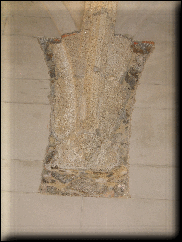The expulsion of the community after 1945
 After the total surrender in May 1945 Abbot Tecelin Jaksch made every effort to bring about a return of the Monastery of Vyšší Brod, as well as the restoration of the monastery and its property to the legal monastic community, which came about very soon, thanks to his contacts, especially to President Beneš, who had also come back. According to this, the continued existence seemed to be assured and everything to be able to go on again as before. But it turned out soon that hostility toward the monastery by the authorities, under strong communist influence from the very beginning, remained in no way behind the Nazi persecution. The expulsion of the German population living here had already started. Some of the order priests who were pastors in the incorporated parishes were expelled together with their parishioners. Others succeeded in escaping across the nearby Austrian border or resettling in Austrian monasteries through Abbot Tecelin’s negotiations with Czechoslovak authorities, and through the negotiations of Abbot Karl Braunstorfer of Heiligenkreuz (who should be gratefully remembered here) with the Austrian authorities. Among the Vyšší Brod community, connections to Austria, especially to Linz and Vienna, even family relationships, were much closer than those to České Budějovice or Prague. And the Cistercian Order in Austria, unlike that in Germany, had a number of old monasteries that were willing to accept and employ the brothers from Vyšší Brod. These monasteries were Heiligenkreuz, Rein, which had no abbot at that time and received, due to shortage of personnel, most of the brothers from Vyšší Brod, and further Lilienfeld, Zwettl and finally Wilhering, the mother monastery of Vyšší Brod.
After the total surrender in May 1945 Abbot Tecelin Jaksch made every effort to bring about a return of the Monastery of Vyšší Brod, as well as the restoration of the monastery and its property to the legal monastic community, which came about very soon, thanks to his contacts, especially to President Beneš, who had also come back. According to this, the continued existence seemed to be assured and everything to be able to go on again as before. But it turned out soon that hostility toward the monastery by the authorities, under strong communist influence from the very beginning, remained in no way behind the Nazi persecution. The expulsion of the German population living here had already started. Some of the order priests who were pastors in the incorporated parishes were expelled together with their parishioners. Others succeeded in escaping across the nearby Austrian border or resettling in Austrian monasteries through Abbot Tecelin’s negotiations with Czechoslovak authorities, and through the negotiations of Abbot Karl Braunstorfer of Heiligenkreuz (who should be gratefully remembered here) with the Austrian authorities. Among the Vyšší Brod community, connections to Austria, especially to Linz and Vienna, even family relationships, were much closer than those to České Budějovice or Prague. And the Cistercian Order in Austria, unlike that in Germany, had a number of old monasteries that were willing to accept and employ the brothers from Vyšší Brod. These monasteries were Heiligenkreuz, Rein, which had no abbot at that time and received, due to shortage of personnel, most of the brothers from Vyšší Brod, and further Lilienfeld, Zwettl and finally Wilhering, the mother monastery of Vyšší Brod.
